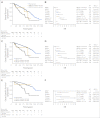Germline BRCA mutations are associated with higher risk of nodal involvement, distant metastasis, and poor survival outcomes in prostate cancer
- PMID: 23569316
- PMCID: PMC3641696
- DOI: 10.1200/JCO.2012.43.1882
Germline BRCA mutations are associated with higher risk of nodal involvement, distant metastasis, and poor survival outcomes in prostate cancer
Abstract
Purpose: To analyze the baseline clinicopathologic characteristics of prostate tumors with germline BRCA1 and BRCA2 (BRCA1/2) mutations and the prognostic value of those mutations on prostate cancer (PCa) outcomes.
Patients and methods: This study analyzed the tumor features and outcomes of 2,019 patients with PCa (18 BRCA1 carriers, 61 BRCA2 carriers, and 1,940 noncarriers). The Kaplan-Meier method and Cox regression analysis were used to evaluate the associations between BRCA1/2 status and other PCa prognostic factors with overall survival (OS), cause-specific OS (CSS), CSS in localized PCa (CSS_M0), metastasis-free survival (MFS), and CSS from metastasis (CSS_M1).
Results: PCa with germline BRCA1/2 mutations were more frequently associated with Gleason ≥ 8 (P = .00003), T3/T4 stage (P = .003), nodal involvement (P = .00005), and metastases at diagnosis (P = .005) than PCa in noncarriers. CSS was significantly longer in noncarriers than in carriers (15.7 v 8.6 years, multivariable analyses [MVA] P = .015; hazard ratio [HR] = 1.8). For localized PCa, 5-year CSS and MFS were significantly higher in noncarriers (96% v 82%; MVA P = .01; HR = 2.6%; and 93% v 77%; MVA P = .009; HR = 2.7, respectively). Subgroup analyses confirmed the poor outcomes in BRCA2 patients, whereas the role of BRCA1 was not well defined due to the limited size and follow-up in this subgroup.
Conclusion: Our results confirm that BRCA1/2 mutations confer a more aggressive PCa phenotype with a higher probability of nodal involvement and distant metastasis. BRCA mutations are associated with poor survival outcomes and this should be considered for tailoring clinical management of these patients.
Conflict of interest statement
Authors' disclosures of potential conflicts of interest and author contributions are found at the end of this article.
Figures



Comment in
-
Re: Germline BRCA mutations are associated with higher risk of nodal involvement, distant metastasis, and poor survival outcomes in prostate cancer.J Urol. 2013 Dec;190(6):2093. doi: 10.1016/j.juro.2013.08.101. Epub 2013 Sep 6. J Urol. 2013. PMID: 24209519 No abstract available.
References
-
- Ferlay J, Shin HR, Bray F, et al. Estimates of worldwide burden of cancer in 2008: GLOBOCAN 2008. Int J Cancer. 2010;127:2893–2917. - PubMed
-
- Jemal A, Bray F, Center MM, et al. Global cancer statistics. CA Cancer J Clin. 2011;61:69–90. - PubMed
-
- Eeles RA. Genetic predisposition to prostate cancer. Prostate Cancer Prostatic Dis. 1999;2:9–15. - PubMed
-
- Edwards SM, Eeles RA. Unravelling the genetics of prostate cancer. Am J Med Genet C Semin Med Genet. 2004;129C:65–73. - PubMed
MeSH terms
Substances
Grants and funding
LinkOut - more resources
Full Text Sources
Other Literature Sources
Medical
Miscellaneous

